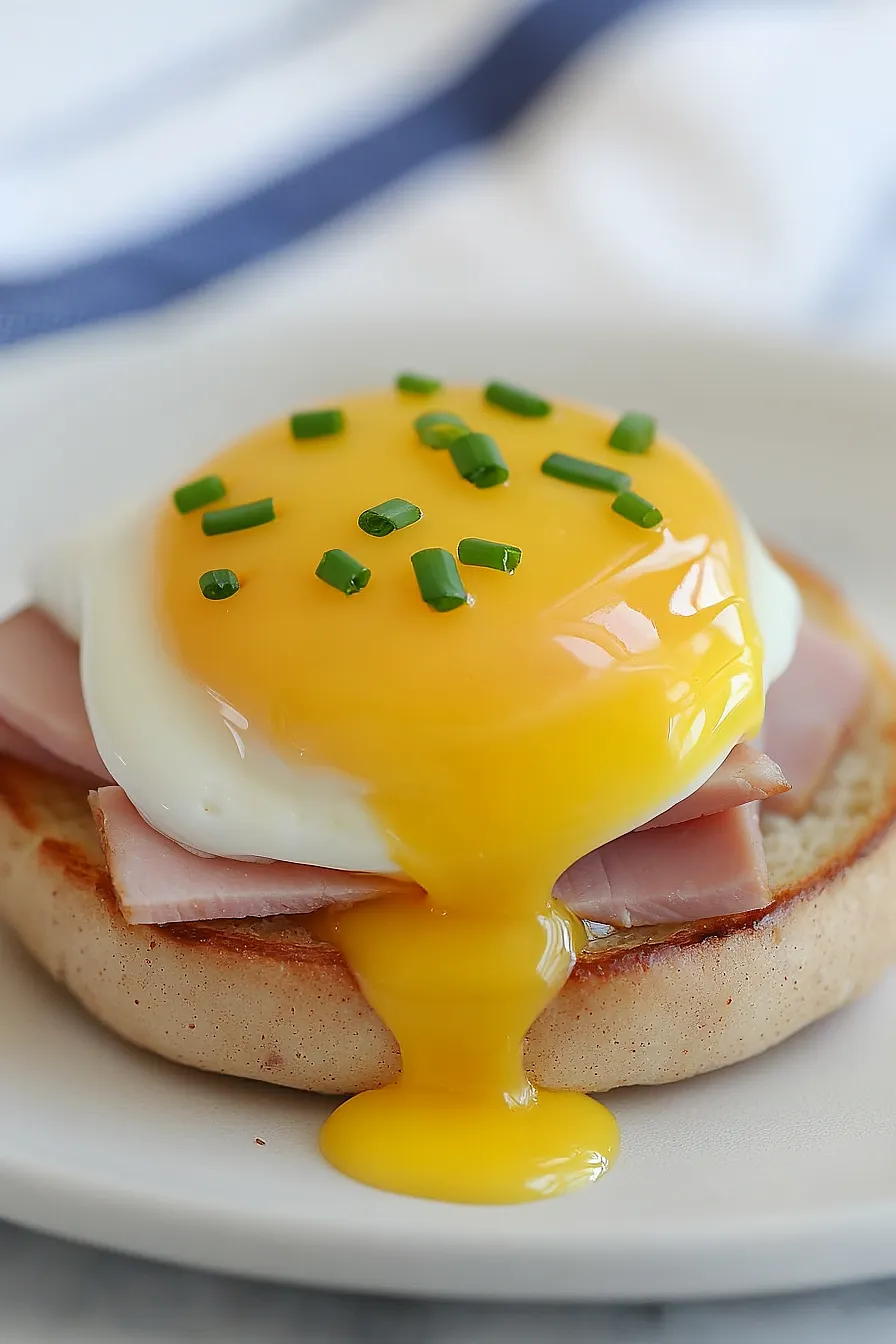I was well into my thirties before I attempted making Eggs Benedict at home. Growing up, it was strictly a “restaurant-only” dish in our family. Mom would order it every Sunday after church, but the thought of making that sauce at home seemed way too scary.
Turns out, I was letting my fear of hollandaise get the better of me. Like most cooking techniques that seem complicated at first, making this classic breakfast dish isn’t as tricky as I’d imagined. With a few simple steps and the right temperature control, you can make restaurant-quality Eggs Benedict right in your own kitchen.
Why You’ll Love This Eggs Benedict
- Restaurant-quality breakfast – You can make this classic brunch dish right at home for a fraction of the cost of dining out, and it tastes just as good as your favorite café’s version.
- Quick preparation – Despite its fancy appearance, this recipe comes together in just 30 minutes – perfect for weekend brunch without spending all morning in the kitchen.
- Simple ingredients – You only need a handful of basic ingredients that are easy to find at any grocery store – eggs, English muffins, Canadian bacon, and a few pantry staples.
- Customizable recipe – While this is the classic version, you can easily swap Canadian bacon for smoked salmon, spinach, or avocado to make it your own.
What Kind of Eggs Should I Use?
For eggs benedict, fresh eggs are really important since you’ll be poaching them. The fresher your eggs, the better they’ll hold together in the water, giving you those picture-perfect poached eggs with neat, compact whites. Large eggs are the standard size for this recipe, and they’ll give you the best results both for poaching and for making your hollandaise sauce. If you’re not sure about the freshness of your eggs, here’s a quick test: put them in a bowl of water – fresh eggs will sink and lay flat on their side, while older eggs will stand upright or float. When you’re ready to poach, make sure your eggs are cold from the fridge, as this helps them hold their shape better in the hot water.
Options for Substitutions
While Eggs Benedict is a classic recipe, you can still make some smart swaps if needed:
- English muffins: You can swap these for thick-cut sourdough, brioche, or regular toast. Just make sure the bread is sturdy enough to hold up under the eggs and sauce.
- Canadian bacon: Regular ham, turkey, smoked salmon, or even cooked spinach (for a vegetarian version) work great here. Each will give the dish its own special twist.
- Eggs: For the poached eggs, there’s really no substitute – they’re essential to a true Eggs Benedict. However, you can use an egg poaching pan if you find the traditional method tricky.
- Hollandaise ingredients: For the sauce, the egg yolks and butter are must-haves – they’re what make hollandaise, hollandaise! But you can swap heavy cream with whole milk, and lemon juice can be replaced with lime juice.
- Vinegar: Any light-colored vinegar works for poaching eggs – try white wine vinegar, rice vinegar, or even lemon juice if you’re out of regular vinegar.
Watch Out for These Mistakes While Cooking
The trickiest part of Eggs Benedict is getting the hollandaise sauce just right – the most common mistake is applying too much direct heat, which can quickly turn your smooth sauce into scrambled eggs. Instead, use gentle, indirect heat from a double boiler and whisk constantly to achieve that perfect, silky texture. When poaching eggs, many cooks skip the vinegar or forget to create a gentle whirlpool in the water, but these steps are crucial for keeping the egg whites together and achieving that perfect oval shape. Temperature control is also essential – your hollandaise should never get too hot (keep it around 145°F), and your poaching water should be just below simmering (around 180°F) to prevent the eggs from becoming tough or rubbery. For the best results, serve immediately after assembling, as hollandaise sauce can start to separate if it sits too long, and the English muffins can become soggy under poached eggs that rest too long.
What to Serve With Eggs Benedict?
Since Eggs Benedict is such a rich breakfast dish, it’s nice to balance it out with some lighter sides that complement without overwhelming. A simple mixed green salad dressed with just olive oil and lemon juice helps cut through the richness of the hollandaise sauce. I love serving some crispy breakfast potatoes or hash browns on the side – they’re perfect for soaking up any extra sauce that drips onto the plate. For a fresh touch, add some sliced avocado or fresh fruit like berries or orange segments to brighten up the plate and add some nice color. If you’re serving this for brunch, a mimosa or bloody mary makes the perfect drink pairing!
Storage Instructions
Keep Components Separate: Eggs Benedict is best enjoyed fresh, but if you have leftovers, store the components separately. Keep the cooked Canadian bacon and English muffins in an airtight container in the fridge for up to 2 days. The hollandaise sauce needs special attention – it’s a bit tricky to store since it can separate.
Save the Sauce: If you need to save leftover hollandaise sauce, place it in an airtight container and keep it in the fridge for no more than 1-2 days. Just know that it might separate and won’t have quite the same smooth texture as when freshly made.
Warm Up: To serve leftover Eggs Benedict components, toast the English muffins until crispy, and warm the Canadian bacon in a pan or microwave. For the hollandaise, warm it very gently in 15-second intervals in the microwave, stirring between each interval. If it’s separated, try whisking in a tiny splash of hot water to bring it back together.
Prep Ahead: Want to get ahead? You can poach eggs in advance and store them in cold water in the fridge for up to 24 hours. When you’re ready to serve, just dip them in hot water for about 30 seconds to warm them up.
| Preparation Time | 10-15 minutes |
| Cooking Time | 15-20 minutes |
| Total Time | 25-35 minutes |
| Level of Difficulty | Medium |
Estimated Nutrition
Estimated nutrition for the whole recipe (without optional ingredients):
- Calories: 1200-1400
- Protein: 50-60 g
- Fat: 80-90 g
- Carbohydrates: 80-100 g
Ingredients
- 2 english muffins
- 4 large eggs
- 4 slices of canadian bacon
- A splash of vinegar
- 4 tablespoons of butter
- 4 egg yolks
- 2 teaspoons lemon or lime juice
- 1 tablespoon heavy cream
- Salt and pepper (to taste)
Step 1: Prepare the Hollandaise Sauce
Melt the butter in a small saucepan over low heat.
In a separate small bowl, beat the egg yolks, then mix in the lemon juice, whipping cream, and a dash of salt and pepper.
To temper the eggs and prevent curdling, add a small spoonful of the hot melted butter to the egg mixture and stir well.
Continue to add the butter, a spoonful at a time, stirring continuously.
Once all the butter has been incorporated, pour the mixture back into the saucepan.
Cook on low heat, stirring constantly, for 20-30 seconds before removing from heat.
The sauce will thicken as it cools.
If needed, add a splash of cream to reach the desired consistency.
Step 2: Poach the Eggs
Fill a medium-sized pot with about 3 inches of water and bring it to a boil.
Reduce the heat to maintain a simmer, with small bubbles occasionally reaching the surface.
You may add a splash of vinegar to the water to help the egg whites coagulate.
Crack one egg into a small cup or measuring cup, then gently lower it into the simmering water.
Allow the egg to cook for 3-5 minutes, depending on your preferred yolk softness.
Use a slotted spoon to carefully remove the poached egg.
It’s normal for white foam to appear on the water’s surface; simply skim it off with a spoon.
Step 3: Prepare the Canadian Bacon
While the egg is poaching, place slices of Canadian bacon in a large pan.
Cook them over medium-high heat for about 1 minute on each side until they are lightly browned and heated through.
Step 4: Assemble the Dish
Toast the English muffin halves until golden brown.
On each toasted side, place a slice or two of the cooked Canadian bacon, followed by a poached egg.
Top generously with the prepared hollandaise sauce.
Serve immediately for a delicious, classic dish.


